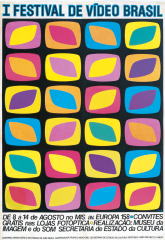- Fotoptica
- Museu da Imagem e do Som (São Paulo)
In 1983, video was a brand new, challenging media. Artists from all over the world were dazzled by its fresh and yet unexplored possibilities. A sense of discovery marked the I Festival de Vídeo Brasil. The Festival took place at Museu da Imagem e do Som (Museum of Image and Sound), was sponsored by Fotoptica, and supported by Secretaria de Estado da Cultura de São Paulo (Secretary for Culture of the State of São Paulo). The competitive exhibition featured 35 videos, most of which were documentary films. The winner work, by theater director José Celso Martinez Correa, discussed the use of video by theatre and plastic artists. The Festival’s premier edition was groundbreaking, one of the first events in Brazil for the then-new media. The historic exhibition featured videos, performances, installations, and a trade show for new technology, including computers, teletext, and videogames. The overall feeling was one of criticism regarding the monopoly of non-cable TV, which did not recognize video as a new art form. Video was still searching for an output that would best suit the up and coming language.
Visual identity and graphic design | Kiko Farkas

Programme
competitive show
Competitive Show | 1st Festival
The 1st Festival’s Competitive Show received 78 submissions (29 in VHS and 49 in U-Matic), from which 36 works were shortlisted (7 in VHS and 29 in U-Matic), amounting to 12 hours of projections.
film and/or video screenings
Glauber Rocha
One of the most important trends in production during the period, the exhibition on Glauber Rocha features tapes that opened up new vistas for different uses for video.
Parallel Show
Video productions for TV: Voando com os pés no chão, winner of the 1st Festival Carioca de Vídeo; Já que ninguém me tira para dançar, featuring statements about Leila Diniz; and the trailer of feature film Beijo ardente/Overdose.
exhibition
Video Installations, Videoverso
The Videoinstalações (Videoinstallations) created by the Videoverso group consisted of six video sets that portrayed television as an integrated element into the lives of people, in a parody of relationships: objet x image x situation.
performance
"Cavaleiro do Apocalipse", Otávio Donasci
The Cavaleiro do Apocalipse (Horseman of the Apocalypse) performance was conceived using the language of videotheater, created by the artist Otávio Donasci himself. The original idea was to portray the hopelessness of the global scenario. The performance was enacted in the Festival’s opening night.
public programs
Round Table Debate: "Legislation"
The debate focused on issues from the relationship between videomakers and distribution channels, equipment import restrictions stemming from emerging technology laws, and the monopoly issue.
Round Table Debate: "Memory and Television"
The debate focused on the need to preserve the more significant events from TV history, in terms of both the medium itself and of the country’s memory. The meeting also addressed selection criteria, techniques for preservation and control, and the future memory
Round Table Debate: "TV - Technique and Language"
The topics discussed were: opposition between the traditional TV format and videotape aesthetics; broadcasting space for then-new languages and technologies; and fascination with sophisticated techniques and its implications on language and the market.